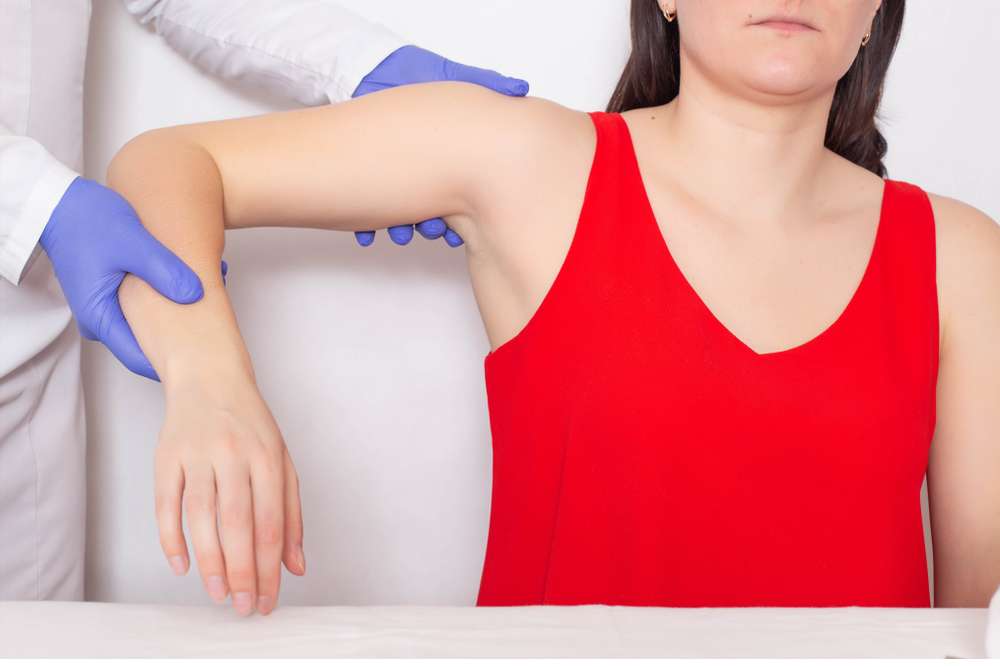Your shoulder is one of the most important joints in your body. Along with muscles, ligaments, and tendons, the shoulder joints attach the arm to your body. The shoulder is the most flexible and complex joint in the entire body.
Shoulder Anatomy
Three main bones make up the shoulder:
- The collarbone (clavicle)
- The shoulder blade (scapula)
- The upper arm bone (humerus)
These three bones work in tandem with over a dozen tendons, muscles, and ligaments to give the shoulder its range of motion and stability. This range of motion and flexibility allows you to play sports and complete many daily activities. With the complexity of the shoulder and the various movements and flexibilities it is capable of, the shoulder is susceptible to a myriad of injuries.
Commonly recognized parts of the shoulder:
- Rotator cuff – group of muscles and tendons that form a protective “cuff” surrounding and keeping the humerus in place. The “rotator” aspect of this term comes from the function of the muscles in this joint. They allow the arm to have a wide range of rotation at the shoulder.
- Labrum – made up of cartilage that forms a ring keeping the upper arm bone in place at the shoulder joint. The biceps muscle also attaches to the labrum.
- Capsule – the ligament that surrounds the shoulder joint
What Is Shoulder Instability?
Shoulder instability is a condition affecting the glenohumeral joint. This joint is the main joint of the shoulder–the attachment point for the arm and body. When the tendons and ligaments of the shoulder become lax, torn, or detached, the upper arm bone shifts out of place, causing instability.
The glenohumeral joint is a ball-and-socket joint, with the head of the humerus being the ball, and the socket is the point at which the clavicle and scapula join. The glenohumeral joint is very shallow and therefore lacks adequate bony support, instead relying on the ligaments and tendons for stability. Because tendons and ligaments are easier to injure than bone, the shoulder is more susceptible to injury and instability.
Dislocation and Subluxation
When the tendons or ligaments are damaged, the head of the humerus is prone to subluxation or dislocation. Damaged tissues allow the humerus to begin to slip away from the socket created by the scapula and clavicle. If the humerus slips partially out of the joint, this is called a subluxation. If the humerus slips completely out of the socket, this is called a dislocation.
Labral Tear
When the labrum is torn or peeled off the glenoid, it is called a labral tear. Trauma, dislocation, or repetitive motion injury can cause a labral tear.
- SLAP tear- A Superior Labrum Anterior to Posterior tear occurs when the tear involves the attachment site of the biceps tendon at the top of the shoulder.
- Bankart tear – A labrum tear that causes the humeral head to shift forward towards the front of the body.
Rotator Cuff Injury
Usually accompanied by a dull ache that worsens at night, rotator cuff injuries are common and are usually the result of overuse, repeated overhead movements, and age. Risk factors include:
- Age
- Certain Occupations
- Sports
- Family History
What Causes Shoulder Instability?

If your shoulder has been dislocated once, it is at a higher risk for future dislocation and is even more likely if you experience a dislocation before age 30.
Other activities, particularly repetitive tasks, can lead to muscle or tendon strain. If the muscles and tendons surrounding the shoulder joint weaken, your shoulder might feel unstable. Without proper rest and treatment, this can lead to dislocation, subluxation, or tear to the tendons.
Shoulder instability is a common complication of long-term sports participation. The rate of instability is higher in sports with limited variety in body movement in combination with repetition. Swimmers, weight lifters, and tennis players see increased shoulder instability over other sports.
Not all shoulder instability is caused by trauma. Some people are just born with looser connective tissues, allowing for dislocation or subluxation to occur spontaneously or only with a minor injury. Several congenital disorders, such as Ehler’s Danlos Syndrome, can also lead to joint instability. Seizure disorders also can lead to dislocation or subluxation as the spasming muscles can put enough strain on the surrounding connective tissues to pull the joint out of place.
Signs and Symptoms of Shoulder Instability
If your instability is caused by trauma, you will most likely know quickly. Instability due to overuse, mild tears, or laxity might be less visually apparent. Common signs and symptoms can include, but are not limited to:
- Pain, which can be sharp and sudden (usually trauma) or dull and throbbing (chronic or post trauma)
- The feeling of joint giving way
- A clicking or popping sound when moving the joint
- Decreased range of motion
- Swelling, which usually accompanies a dislocation or subluxation
- Repeated or prior dislocations or subluxations
- Weakness
Diagnosis
If you experience a trauma to the shoulder, it is important to have it evaluated by a qualified orthopedic doctor as soon as possible. If you are not treated in the ER, you must schedule an appointment for evaluation and management. Orthopedic doctors are standing by at AICA Orthopedics to help you through this process.
Manual Examination
The first step is a physical examination of the joint. Obvious signs of deformity, bruising, or swelling indicate the next steps to take.
If there is not an emergent need for imaging, your doctor may perform one of several manual tests to determine the extent of instability or cause of shoulder pain. These tests can include palpating the area to pinpoint areas of tenderness and discomfort. Also important is notating the extent (or lack) of range of motion, strength, and sensation.
Imaging
After a physical exam, images will be taken to ascertain what is happening below the skin. X-rays are used to view bones and will help your doctor diagnose dislocation, subluxation, and any associated fracturing. After a dislocation is repaired, a follow-up x-ray will be taken to ensure proper positioning of the bones.
If a tear of surrounding tendons or ligaments is suspected, the most reliable form of imaging diagnosis is an MRI (Magnetic resonance imaging).
An MRI is also used to diagnose conditions of the shoulder not caused by trauma. An MRI can be used to identify the source of pain in chronic shoulder pain patients and the condition of ligaments and tendons in patients with instability caused by congenital conditions. Rarely, a CT (computed tomography) is done, but it is not as common with shoulder instability diagnostics.
Treatment for Shoulder Instability
Seeking prompt medical treatment as soon as you notice an issue with your shoulder is important to promote effective healing. Treating shoulder instability and should pain is not a one size fits all situation. Our goal is to relieve pain and discomfort while building strength to stabilize your shoulder. Some patients will require nothing more than rest. Other patients might require physical therapy or more extensive treatment like surgery.
Surgery is usually the second line of treatment but is more commonly used with patients playing sports and looking for the most secure repair to allow them back in the field.
Non-Surgical Treatment Options

After a dislocation, subluxation, or soreness related to muscle or tendon injury rest, light stretching, and icing before and after exercise are ideal. These will soothe aches, allow healing time, and strengthen the area. If you are experiencing shoulder pain from overuse of the joint, you can also implement modifications to your daily activities to help relieve pressure and strain on the area. Nonsteroidal anti-inflammatories (NSAIDs) can be used to decrease pain and swelling in combination with ice and rest.
Physical Therapy is used to strengthen the area of your injury and instability as well as relieve pain. Physical therapy for should instability can include stretching, strength training, joint manipulation (carefully to prevent increased instability), and even massage therapy. Physical therapy is a combination approach instead of one treatment over and over.
Sometimes in combination with the above treatments, your orthopedist might recommend bracing your shoulder. This will restrict movement while injuries heal or prevent dislocation or subluxation and is ideal for the first 1-2 weeks post-injury.
Surgical Options
After discussion with your AICA Orthopedics team, if the decision is made that non-surgical options are not working, it might be time to proceed with surgical intervention. Our goal is to ensure expert treatment and thorough recovery after surgery. Most surgeries done on the shoulder can be done arthroscopically. Arthroscopic surgery requires a small incision and the insertion of both a camera for visualization and instruments needed to complete repairs. Arthroscopic surgery results in less tissue damage, shorter recovery time, and often less pain.
During surgery, your surgeon will repair any torn tissue with simple sutures or sutures reinforced with metal or plastic anchor points. The anchor points are sunk into the surrounding bone for firm placement. Similar techniques can be used to tighten and reinforce tendons, ligaments, and muscles.
Capsular Shift Surgery
This surgery is performed when the capsule surrounding the shoulder joint is too big and is causing shoulder instability. This surgery will tighten the capsule, often by “tucking” the ligament to shorten it, securing it with sutures, or sutures and anchors, and stabilizing the shoulder.
Rotator Cuff Repair
Ideally, a rotator cuff injury will be treated with non-surgical options. However, if you do not see improvements after 6-12 months, surgical intervention could be necessary. Our expert orthopedic surgeons at AICA Orthopedics will reattach the cuff’s tendons to the upper arm bone if necessary. If the tear isn’t as severe, it might be possible to debride, trim, and smooth the tear to promote healing.
Labrum Repair
If the labrum has a tear, it will most likely need surgical repair. This surgery is best done arthroscopically due to the angle and small operating area. The labrum, or soft cartilage, is repaired using sutures and occasionally anchors, similar to a rotator cuff repair.
Occasionally, for severe instability or injuries, open surgery is required. This involves a larger incision to gain access to the entirety of the joint, capsule, and tendons. It will involve a longer healing time and occasionally longer rehabilitation post-surgery.
Even with surgery, all orthopedic surgeries require a rehab period. This will often include physical therapy, massage therapy, and medication management. Physical therapy is highly beneficial to the healing of both bones and soft tissues after surgery. It helps increase your range of motion (imperative for the most flexible joint, the shoulder), improve flexibility, and strengthen the joint to prevent future injury. The goal is to safely get you back to your daily activities, prevent complications, and ensure the long-term success of your surgery.
What Now?
To learn more about shoulder instability, please reach out to AICA Orthopedics. AICA Orthopedics has staff standing by 24/7 to advise and evaluate you for optimal healing. Prompt treatment in orthopedics is key to the success of healing injuries, whether traumatic or chronic. AICA Orthopedics has a staff of orthopedic surgeons, sports injury specialists, chiropractors, physical therapists, and other team members ready to collaborate on your treatment plan today!


